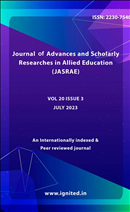Leveraging BIM (Building Information Modelling): Risk Management of Composite Building Structures in Hilly Area
Keywords:
BIM, risk management, composite building structures, hilly area, AEC industry, digital technologies, knowledge-based systems, IT-based solutions, construction safety, technology advancementsAbstract
Risk management is a concern that affects the entire AEC (Architecture, Engineering, andConstruction) industry. Inadequate risk management may affect how cities will develop in the future,how land will be used, and how cities will be designed, in addition to making it more challenging toaccomplish the project's goals. Due to the BIM (Building Information Modelling) and BIM-related digitaltechnologies' rapid expansion and adoption, It is essential to do a detailed analysis of theseinnovations' current state of the art. This article reviews the most recent technology-based riskmanagement approaches, including BIM and automatic rule checking. Knowledge-based systems andIT-based reactive and proactive safety solutions are increasingly employed in addition to traditionalrisk management methods. The results demonstrate that BIM may function as a foundation for otherBIM-based tools to conduct additional risk analysis and as a tool to support the project developmentprocess as a methodical risk assessment tool. Currently, the administration of construction workers'safety receiving the most attention, as recent efforts have mainly been concentrated on analyzingtechnology advancements.For planning, design, construction, and operation, data may be acquired, reviewed, and monitored using3D models in a coordinated and consistent manner. The creation of an intelligent 3D model is the firststep in the construction information modelling (BIM) process, which aids in decision-making forconstruction and infrastructure projects. Using this method, data organization, analysis, and recordingmay be planned, created, and used it is a process that begins with the creation of an intelligent 3D modelthat may be used to gather, evaluate, and manage data related to planning, design, construction, andoperating issues in order to better guide decision-making for infrastructure and construction projects.The paper outlines a risk management method that makes use of routine inputs, anticipated outcomes,and project experience to its advantage. The research also includes a quick evaluation of the BIMemploying Excel information technology. The system was built and the work was finished using thistechnology.References
Eastman, C., Teicholz, P., Sacks, R. & Liston, K. (2008). BIM handbook: A guide to building information modeling for owners, managers, designers, engineers and contractors. John Wiley & Sons.
Zhang, C.; Chen, J.; Sun, X.; Hammad, A. Lifecycle evaluation of building sustainability using BIM and RTLS. In Proceedings of the Winter Simulation Conference 2014, Savannah, GA, USA, 7–10 December 2014.
Alhamami, A.; Petri, I.; Rezgui, Y.; Kubicki, S. Promoting energy efficiency in the built environment through adapted bim training and education. Energies 2020, 13, 2308. [CrossRef]
Ajayi, S.O.; Oyedele, L.O.; Ceranic, B.; Gallanagh, M.; Kadiri, K.O. Life cycle environmental performance of material specification: A BIM-enhanced comparative assessment. Int. J. Sustain. Build. Technol. Urban Dev. 2015, 6, 14–24. [CrossRef]
Taha, F.F.; Hatem, W.A.; Jasim, N.A. Effectivity of BIM technology in using green energy strategies for construction projects. Asian J. Civ. Eng. 2020, 21, 995–1003. [CrossRef]
Doan, D.T.; GhaffarianHoseini, A.; Naismith, N.; Ghaffarianhoseini, A.; Zhang, T.; Tookey, J. Examining critical perspectives on building information modelling (BIM) adoption in New Zealand. Smart Sustain. Built Environ. 2020, 10, 594–615. [CrossRef]
Singh, M.M.; Geyer, P. Information requirements for multi-level-of-development BIM using sensitivity analysis for energy performance. Adv. Eng. Inform. 2020, 43, 101026. [CrossRef]
Eleftheriadis, S.; Mumovic, D.; Greening, P. Life cycle energy efficiency in building structures: A review of current developments and future outlooks based on BIM capabilities. Renew. Sustain. Energy Rev. 2017, 67, 811–825. [CrossRef]
Yin, X.; Liu, H.; Chen, Y.; Wang, Y.; Al-Hussein, M. A BIM-based framework for operation and maintenance of utility tunnels. Tunn. Undergr. Space Technol. 2020, 97, 103252. [CrossRef]
Di Bari, R.; Jorgji, O.; Horn, R.; Gantner, J.; Ebertshäuser, S. Step-by-step implementation of BIM-LCA: A case study analysis associating defined construction phases with their respective environmental impacts. In IOP Conference Series: Earth and Environmental Science; IOP Publishing: Bristol, UK, 2019.











